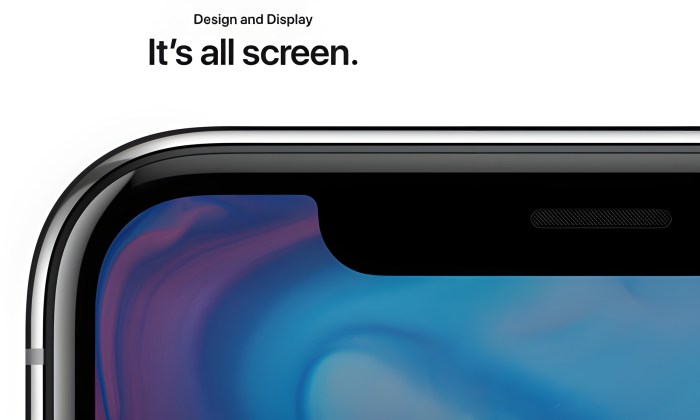The iPhone X
The iPhone X, released in 2017, marked a significant turning point in the history of smartphones. It was a bold departure from previous iPhone models, introducing groundbreaking features that redefined user expectations and set the stage for future smartphone innovations.
The iPhone X’s Key Features
The iPhone X was a technological marvel, pushing the boundaries of what a smartphone could be. It boasted a sleek, edge-to-edge display, a powerful A11 Bionic chip, and an advanced dual-camera system. It also introduced Face ID, a revolutionary facial recognition system that replaced the traditional Touch ID fingerprint sensor.
The iPhone X’s most notable feature was its edge-to-edge OLED display, which extended to the very edges of the device, creating a truly immersive viewing experience. This innovative design eliminated the bezels that were common on previous iPhone models, maximizing the screen real estate.
The iPhone X’s Features Compared to Previous iPhone Models
The iPhone X was a significant upgrade from its predecessors, offering a substantial leap in performance, design, and functionality.
- Display: The iPhone X’s edge-to-edge OLED display was a dramatic departure from the LCD displays found on previous iPhones. It offered superior color accuracy, deeper blacks, and a higher contrast ratio, delivering a more vibrant and immersive viewing experience.
- Processor: The A11 Bionic chip, powering the iPhone X, was the most powerful processor ever used in an iPhone. It delivered lightning-fast performance, enabling seamless multitasking, graphics-intensive gaming, and augmented reality experiences.
- Camera: The iPhone X featured a dual-camera system with a telephoto lens, offering improved zoom capabilities and a wider range of shooting possibilities. The camera system also incorporated advanced features like Portrait Mode, which enabled users to create professional-quality depth-of-field effects.
- Face ID: The iPhone X introduced Face ID, a facial recognition system that used a sophisticated 3D sensor to map the user’s face. Face ID provided a more secure and convenient method of unlocking the device compared to the Touch ID fingerprint sensor found on previous iPhones.
The iPhone X’s Design and Functionality
The iPhone X’s design and functionality challenged the expectations of smartphone technology. The edge-to-edge display and the absence of a home button were a bold departure from the traditional smartphone design, ushering in a new era of sleek, minimalist aesthetics.
The introduction of Face ID also marked a significant shift in how users interacted with their devices. It eliminated the need for a physical home button and introduced a more intuitive and secure method of authentication. The iPhone X’s design and functionality set the stage for future smartphone innovations, paving the way for devices with even larger displays, more powerful processors, and more sophisticated biometric authentication systems.
The “Impossible” Features: Iphone X Seemed Impossible At Some Point
The iPhone X, launched in 2017, was a groundbreaking device that pushed the boundaries of smartphone technology. Many of its features, considered impossible to achieve at the time, were made possible by Apple’s relentless pursuit of innovation and engineering prowess.
Technological Challenges Overcome
The iPhone X’s revolutionary features required overcoming significant technological hurdles. Here are some of the key challenges and their solutions:
- Face ID: Apple’s Face ID, a facial recognition system that replaced the traditional fingerprint scanner, was a technological leap forward. The challenge lay in creating a system that could accurately identify users in various lighting conditions, with different facial expressions, and even with accessories like glasses or hats. Apple addressed this by using a sophisticated 3D sensor system called TrueDepth camera, which maps the user’s face in depth, making it highly accurate and secure.
- Edge-to-Edge Display: The iPhone X’s edge-to-edge display, eliminating the bezels that surrounded the screen, required innovative solutions. The challenge was to fit all the necessary components, like the camera and sensors, into a smaller space without compromising functionality. Apple solved this by integrating the front-facing camera and sensors into the notch at the top of the display, maximizing the screen real estate.
- Wireless Charging: Wireless charging was a feature that had been around for some time, but it was limited in speed and efficiency. Apple tackled this challenge by implementing a fast and efficient wireless charging solution, allowing users to charge their phones wirelessly without sacrificing speed. This was achieved through a combination of proprietary hardware and software optimization.
Perceptions of Impossibility
The iPhone X’s features were initially met with skepticism and disbelief from industry experts and the public alike. Many believed that these features were simply too difficult to achieve with current technology.
“Apple’s Face ID is a gimmick that won’t work in real-world scenarios,” said one industry analyst.
“The iPhone X’s edge-to-edge display is a design flaw that will compromise functionality,” another expert claimed.
The public also had its doubts, with many questioning the practicality and feasibility of these features.
“Why would I want to use my face to unlock my phone? It’s not secure!” one user commented.
“Wireless charging is a slow and inefficient way to charge your phone. It’s just not worth it,” another user said.
The Impact of the iPhone X
The iPhone X, with its revolutionary edge-to-edge display, facial recognition, and innovative gesture controls, marked a turning point in smartphone design and functionality. It not only reshaped the iPhone lineup but also significantly influenced the broader smartphone industry, leading to a cascade of imitations and innovations.
The Evolution of Smartphone Design
The iPhone X’s impact on smartphone design is undeniable. Its near bezel-less display, achieved through the implementation of a notch, became a defining feature, adopted by numerous manufacturers across the industry. The notch, while initially met with mixed reactions, eventually became a ubiquitous design element, enabling larger screens in smaller form factors. This shift towards a more immersive viewing experience, facilitated by the edge-to-edge display, has significantly altered how users interact with their smartphones.
The Impact on the Smartphone Market
The iPhone X’s release triggered a fierce competition among smartphone manufacturers, pushing them to innovate and deliver comparable features and design aesthetics. The rise of bezel-less displays, facial recognition technology, and gesture-based navigation systems became the new standard, as manufacturers strived to match the iPhone X’s advancements. This competitive pressure resulted in a rapid evolution of smartphone capabilities, offering consumers a wider range of choices and a more diverse landscape of features.
The Adoption of iPhone X Innovations, Iphone x seemed impossible at some point
The iPhone X’s innovations have been widely adopted and adapted by other manufacturers. For example, the notch, initially a defining feature of the iPhone X, has become a common design element in Android devices. Similarly, facial recognition technology, initially pioneered by Apple, has become a standard security feature in many high-end smartphones. Manufacturers have also implemented gesture-based navigation systems, inspired by the iPhone X’s intuitive interface, enhancing user experience and streamlining interactions.
The Legacy of the iPhone X
The iPhone X, released in 2017, wasn’t just another phone; it was a pivotal moment in Apple’s history and the evolution of smartphones. It marked a significant departure from previous designs, introducing revolutionary features that redefined user expectations and paved the way for the future of mobile technology.
The iPhone X’s Innovations Shaped Future iPhones
The iPhone X’s groundbreaking innovations were not just about aesthetics; they laid the foundation for the design and functionality of future iPhone models. The all-screen design, with its edge-to-edge display and the removal of the physical home button, became the defining characteristic of subsequent iPhones. The introduction of Face ID, a secure and convenient biometric authentication system, replaced Touch ID, and has since become a standard feature across Apple’s product line. This shift towards a more immersive visual experience and advanced security measures has been a defining trend in the evolution of the iPhone.
- The iPhone X’s OLED display technology, with its superior color accuracy and deeper blacks, became the standard for future iPhone models, enhancing the visual experience for users.
- The iPhone X’s A11 Bionic chip, with its powerful neural engine, enabled advanced machine learning capabilities, which have been further developed in subsequent iPhone models for features like real-time translation and improved image recognition.
- The iPhone X’s dual-camera system, with its telephoto lens and portrait mode, established a new standard for smartphone photography, and its capabilities have been continuously enhanced in later iPhones.
The iPhone X Continues to Inspire Technological Advancements
The iPhone X’s influence extends beyond Apple’s own product line. Its innovations have inspired other smartphone manufacturers to adopt similar design elements and features, driving the overall advancement of mobile technology.
- The notch, initially introduced on the iPhone X, became a common design element in smartphones from other brands, enabling larger displays and a more immersive viewing experience.
- The use of Face ID technology has become more widespread, with Android manufacturers incorporating similar biometric authentication systems into their devices.
- The iPhone X’s focus on augmented reality (AR) capabilities has spurred innovation in this field, with developers creating a growing number of AR experiences for smartphones.
Iphone x seemed impossible at some point – The iPhone X wasn’t just a phone; it was a catalyst for change. It demonstrated the potential of technology to redefine our expectations and push the boundaries of what’s possible. The iPhone X’s legacy is evident in every smartphone released since, with its innovations shaping the design, functionality, and overall experience of mobile devices. It’s a testament to the power of innovation and the potential for technology to revolutionize our lives.
Remember when the iPhone X with its fancy Face ID was announced? It seemed like something out of a sci-fi movie. Now, even Samsung is making bold moves, like switching fingerprint sensor suppliers for the Galaxy S9 as reported here. It just goes to show that what was once considered impossible can quickly become the new norm in the tech world.
 Standi Techno News
Standi Techno News

